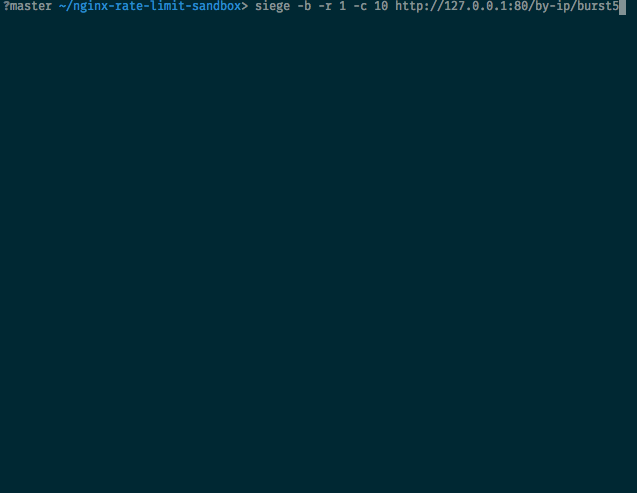NGINX Rate limiting is more traffic-shaping than pure rate-limiting. And this is an important point to understand how it works with the burst and no_delay settings.
Tools: Docker, and Siege (you can brew-it, or use other cli load-testing tools like ab or artillery or anything you like!)
The Nginx config defines a few locations to test the various combinations of:
- limit_req_zone by uri or by ip
- using the burst argument (set to 5 in this case) or not
- adding nodelay to control how to deal with request going over-quota during bursts.
The rates defined are:
- 30 req/min
- burst locations allow a burst of 5
With the leaky bucket, that means a new request should be allowed ever 2 seconds.
The endpoints defined are:
- http://127.0.0.1:80/by-uri/burst0
- http://127.0.0.1:80/by-uri/burst0_nodelay
- http://127.0.0.1:80/by-uri/burst5
- http://127.0.0.1:80/by-uri/burst5_nodelay
- http://127.0.0.1:80/by-ip/burst0
- http://127.0.0.1:80/by-ip/burst0_nodelay
- http://127.0.0.1:80/by-ip/burst5
- http://127.0.0.1:80/by-ip/burst5_nodelay
Run the Nginx in a docker container:
Choose one of:
# If you want to see NGINX logs
docker run -it --rm -p 80:80 sportebois/nginx-rate-limit-sandbox
# If you want to run it in the background
NGINX_CONTAINER_ID=$(docker run -d --rm -p 80:80 sportebois/nginx-rate-limit-sandbox)
# Then when you want to stop and clean it:
docker stop $NGINX_CONTAINER_ID
Using Siege to send 10 concurrent requests at once on the various endpoints The most interesting ones are the burst5 and burst5_nodelay which let you really visualize and remember how nginx deal with burst settings!
siege -b -r 1 -c 10 http://127.0.0.1:80/by-uri/burst0
siege -b -r 1 -c 10 http://127.0.0.1:80/by-uri/burst0_nodelay
siege -b -r 1 -c 10 http://127.0.0.1:80/by-uri/burst5
siege -b -r 1 -c 10 http://127.0.0.1:80/by-uri/burst5_nodelay
siege -b -r 1 -c 10 http://127.0.0.1:80/by-ip/burst0
siege -b -r 1 -c 10 http://127.0.0.1:80/by-ip/burst0_nodelay
siege -b -r 1 -c 10 http://127.0.0.1:80/by-ip/burst5
siege -b -r 1 -c 10 http://127.0.0.1:80/by-ip/burst5_nodelay
When doing these tests, you will want to pay attention to:
- the success/status code (obviously)
- the response time it took, both for the rate-limited requests and the succesfull requests
You should see something like this, then you'll be able to play with all the other various locations/settings: 